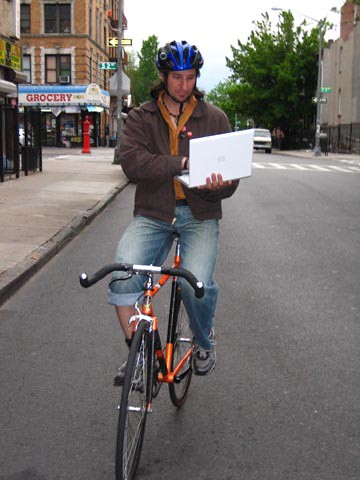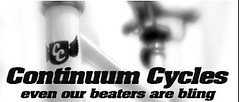Bikes in the news

Photo by Jefferson Seigel
Clockwise from top, cyclists lift their bikes at Houston St. and LaGuardia Pl. for Derek Lane, 23, a cyclist killed by a truck there in June; Mary Beth Kelly speaks on the Hudson River bike path where her husband, Dr. Carl Henry Nacht, was killed in June, as Transportation Alternatives’ Noah Budnick listens; cyclists place flowers on a ghost bike on Third Ave. honoring Reginald Chan.
Heavy lifting as cyclists honor those killed on the road in ’06
By Jefferson Siegel
Bicycle solidarity was on eloquent display last Sunday as hundreds rode in the Second Annual Memorial Ride to honor the 14 riders killed on city streets last year.
Two separate rides started out early in the morning in Queens and the Bronx, stopping at a dozen sites before meeting up midafternoon in the Village. At each stop, friends and colleagues poignantly spoke of their loss in
words usually reserved for close family members.
Risi Kondor, a computer science student at Columbia, rode even though he didn’t know any of the fallen cyclists.
“I think it’s important to make a statement to make this city safer and to commemorate those who can’t be here,” Kondor said as cyclists filled LaGuardia Pl. north of Houston St. at the spot where Derek Lake, 23, was struck and killed by a truck on June 23.
Keen Berger, the Village Democratic district leader and Community Board 2 member, circulated through the crowd with a basket of homemade oatmeal and chocolate chip cookies. Ian Dutton, a public member of C.B. 2’s Traffic and Transportation Committee, lamented the loss of Lake, an aspiring filmmaker, as well as the deaths of other cyclists on Houston St. in recent years, a thoroughfare so deadly it has earned the name “Boulevard of Death.”
“I am dismayed at the Department of Transportation’s disregard for the significance of these fatalities,” Dutton said, “and disappointed by D.O.T.’s efforts to ignore our neighborhood’s insistence that we address the safety issues for the cyclists that use this street.”
As they had on every stop that day, cyclists then held their bikes aloft in a symbolic “bike lift” salute before pedaling east.
At Third Ave. and 17th St., a white ghost bike marked where East Village restaurant owner Reginald Chan was killed last September. Members of Chan’s family stood silently, each holding a single flower. Cyclists dismounted and covered the stark white bike with colorful blooms.
The ride then pedaled west, past Union Square and through Chelsea to Ninth Ave. and 29th St., where Darren Lewis, 20, was killed in August.
On a summer night last June, Dr. Carl Henry Nacht, 56, was killed by a tow truck while he was riding on the bike path along the Hudson River at 38th St. On Sunday his wife, Mary Beth Kelly, surrounded by family and friends, stood before the silent group of riders and recalled how a bystander’s shirt was unable to staunch the blood of her husband’s fatal wound.
“I think the basic human nature is to be compassionate. We’re involved in civic activity; it gives meaning to our lives — connect with our community and think about the things that elevate us,” Kelly offered.
The ride then proceeded down the path to Clarkson St., where Eric Ng, 22, was killed by a drunk driver in December, one of three cyclists killed in the final weeks of the year.
At the last stop, the Memorial for Unnamed Cyclists on Houston and Lafayette Sts., the crowd listened to speeches by the ride’s organizers from Time’s Up! and Transportation Alternatives before performing a final bike lift.
-----------------------------------------
In the Sunday New York Times Magazine was an article on Messenger style and Timbuk 2 bags:
article
Biker Chic
By ROB WALKER
Published: January 14, 2007
Timbuk2
To be a bike messenger, a former member of that profession explains in the documentary “Pedal,” is to be part of a “whole different culture.” The messenger feels free, envied and looked down on all at once. “Bike messengers fall into the realm of outlaw,” he explains. It’s not clear exactly when people delivering things by way of a bike came to be thought of as a “culture,” but in recent years it has become clear that this image is widespread and probably marketable.
For instance, Advertising Age recently included a messenger-bag company called Timbuk2 in its “Marketing 50” list of up-and-coming brands. With sales to messengers “in the bag,” the magazine observed, Timbuk2 has lately “expanded into an urban-lifestyle brand,” with about $20 million in sales a year and growing quickly. The company’s roots go back to 1989, when a San Francisco bike messenger named Rob Honeycutt started making bags and selling them through local bike shops. When this started to look like a real business, he changed the original name — Scumbags — got some financial backing and opened a manufacturing facility in the Mission District. The brand sold made-to-order bags via the Internet and had a solid cult following by the time Honeycutt sold his stake to new investors and left in 2002.
Soon Timbuk2 started to have success with a more diversified product line. The brand now sells backpacks, laptop bags, duffel bags, tote bags, yoga bags and even wallets. Macy Allatt, director of marketing for the company, says that “urban living” is the common thread. While it is unlikely that bag purchases by actual bike messengers make up more than a sliver of Timbuk2 sales these days, they’re still “the reason this company has been successful,” she says. Presumably that’s both because a bag with messenger-ness in its DNA is bound to be ruggedly functional and because of courier culture’s harder-to-define outlaw chic.
Timbuk2 didn’t conjure this chic: the brand is one of many to notice that messengering seems connected to a more vague, but popular, notion of “urban” cycling, which carries a whiff of progressive politics, creativity and preference for the outdoors, even a paved cityscape, to one of the Man’s cubicles. And of course messengers really do care about their bags: ReLoad, Eric Zo and other small brands have devoted followings. But while, for example, messengers have organized competitions and races for years, it is only recently that these events have started attracting major sponsors like Puma. Meanwhile, the light “fixed gear,” or track bikes (which don’t have brakes), that some messengers use have attracted interest from increasing numbers of people who five years ago might have been drawn to skateboards. The makers of a new DVD called “Mash SF” — full of streety stunts (and painful-looking crashes) in the manner of a skate video but with bikes — were recently recruited to contribute to the influential Japanese style Web site Honeyee.com.
This messenger-inspired aesthetic is what Timbuk2 has addressed with its newer products (one bag is called the Blogger) and by expanding distribution to places like college bookstores. “We’re still very much committed to the cycling community,” Allatt says, noting that the brand sponsors messenger races as well as events like the Bicycle Film Festival and has produced a limited-edition artist series. And while many of the new products are made in China, the messenger bags are still made in San Francisco; the company has also introduced “sustainable” bags made of hemp. “We wouldn’t want to alienate where we came from,” Allatt says.
That’s always the trick: as is so often the case, the more popular the image of the messenger as outlaw icon gets, the more quickly the reality behind it recedes. One interesting thing about the documentary “Pedal” — completed in 2001 but recently rereleased with a companion book of photographs — is that it goes well beyond the popular cliché of the messenger as a tattooed, vegan, indie-rocking young man or woman who has made a lifestyle choice to avoid working in a cubicle. “It’s a nonunionized blue-collar job,” and many couriers are working-class dads with few other options, says Peter Sutherland, the director and photographer. “In New York, a lot of times it’s one step up from rock bottom.” That’s a little different from, say, a leisure activity like skateboarding. But we’ll take our fresh outlaw role models where we can find them, even if we find them risking life and limb to deliver packages for the Man.











0 Comments:
Post a Comment
<< Home